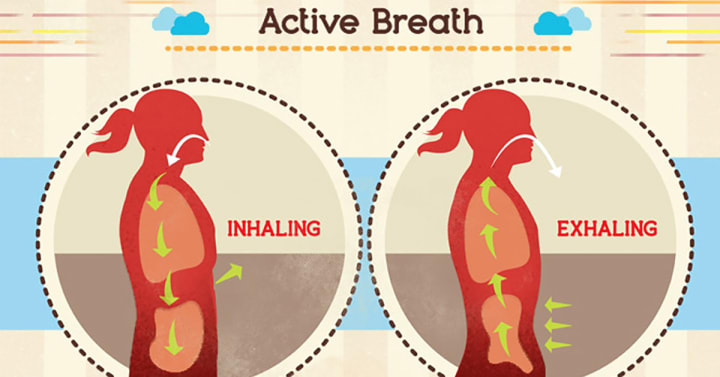Healthy Breathing Exercises
Healthy breathing exercises create an internal rhythm that keeps the body functioning in harmony.

A single wailing breath hails our arrival into the world, just as a single silent one marks our departure from it. Between these all-encompassing two lie hundreds of millions of breaths that matter plenty. How we breathe has a lot to do with how healthy we are. And it may even be that by breathing correctly, as nature intended, we buy a little extra time. Yet about 30 percent of us don’t do it right. Maura Rhodes, well-known health journalist, explored the concept of healthy breathing, amid many others, throughout her career. In a 1989 article for Longevity magazine, Rhodes focused in on stressors that cause irregular breathing, and healthy breathing exercises to reduce such stressors.
We spend all of our time breathing too rapidly and too shallowly—in other words, subtly hyperventilating. By doing so, we cheat ourselves of both health and longevity. Take it from someone who knows: "Breathing creates a kind of internal rhythm that keeps all the organs and systems in the body functioning in physiological harmony. Throw off that rhythm by hyperventilating, and you can easily throw off health," says Robert Fried, Ph.D., director of the Stress and Biofeedback Clinic at the Institute for Rational Emotive Therapy in New York.

Photo via Health365
How could we become so sloppy about something that should come naturally? It's easy, says Dr. Fried, who made breathing his business. Lots of everyday factors can come between us and our breathing rhythm:
- Diet: Some food substances—like the amino acid tyramine found in aged cheese and processed meats—speed up metabolism and breathing as well.
- Illness: Mild anemia, for example, can also do it.
- Posture: For those of us who practice it, the old-school rule that admonishes us to suck in our stomachs can play a part.
- And a proclivity to tight-fitting clothing—what Dr. Fried calls the Calvin Klein syndrome. Or perhaps the bandage dress syndrome.
The major culprit, though, is undoubtedly stress. "People react to stress as animals do to danger—the heartbeat quickens, and so does breathing," explains Dr. Fried. “With humans, this response can stick if there's enough constant stress in a person's life." Not because such a response becomes a habit, like nail biting or lip chewing, but because it undermines the muscles that support breathing.
Healthy breathing depends upon the strength of specific muscles. The abdominal muscles must be strong and, more important, so must the diaphragm—the sheet of muscle sandwiched between the lungs and the abdomen. As every trained singer knows, the diaphragm aids breathing by pushing down on the abdomen with each inhalation, making room for the lungs to expand; on the exhale, the diaphragm stretches up against the lungs to help propel air. According to Dr. Fried, frequent hyperventilation doesn't give the diaphragm enough of a workout, and it becomes weak from underuse.
And that's just the start of it. Hyperventilation deprives the body of carbon dioxide (CO2), which isn't merely a waste product of oxygen metabolism. In the complex chemistry of the body, CO2 is responsible for maintaining the pH balance. Breathe too rapidly, and the carbon dioxide is blown out before it can do its job; blood and other bodily fluids become too alkaline—and that affects the flow of calcium into tissues. When the pH balance is upset, too much calcium rushes into muscles and nerves, making them hypersensitive. As a result, you feel nervous and jittery even in non-stressful situations.
What's more, low CO2 levels cause blood vessels throughout the body to constrict. Blood flow is then reduced, resulting in hypoxia, a decreased level of oxygen in the brain and tissues. Hypoxia has been associated with a string of medical problems ranging from migraine headaches and epilepsy to angina, cancer, and stroke.
Deprived of sufficient oxygen, the body must switch to fuels that don't need as much for burning. Such anaerobic metabolism introduces still another set of health concerns. It impairs the brain's production of neurotransmitters, the chemical messengers that relay every nerve impulse. You may feel the effect in impaired thinking, faltering memory, and dulled sensations—even in emotional disruptions. And the potential problems don't end there. As an alternate fuel, anaerobic breathing calls on glutamate, an amino acid that has recently been implicated in brain-cell loss.
Remedy: a little breathing reeducation and diaphragm muscle work. The simple exercises that follow will allow more oxygen to reach body cells and increase aerobic metabolism. They'll also help you to relax. Do a few when you're anxious, nervous, or just want to wind down—and keep in mind that with every soothing breath, you could be adding a little time to your life.

Image via Healthy Holistic Living
Be a Better Breather
The following are actually individual steps in a single exercise that breaks perfect breathing down into its component parts. By concentrating on each one, you not only become aware of precisely what the body should be doing as it inhales and exhales, but you also strengthen the muscles involved. Do the sequence a couple of times in the morning and evening, always breathing in through your nose to warm and filter the air. Wear something that is comfortable and loose, so as not to inhibit the maximum potential of your breaths.
Belly Breath:Place your right hand on your abdomen and your left hand on your chest. Look down and breathe naturally, noting which hand, if either, moves. Ideally, the stomach hand should rise and fall with each inhalation and exhalation, and the chest hand should stay still. To make this happen: Slowly inhale through your nose to a count of ten, so that the stomach hand moves outward. Exhale to a count of ten, pulling in your stomach on the last few counts to push every drop of air out of your lungs. Repeat two more times and rest; then do two more sets of three. With time and practice, you can leave your hands out of it. Diaphragmatic breathing will become second nature.
Diaphragm Stretch:Sit upright in a comfortable chair, feet flat on the floor and hands resting in your lap. Imagine there's a string wrapped around your abdomen. Try to break it by pushing your belly out as far as it will go. You'll have to inhale in order to push out—and your diaphragm will be working hard to put pressure on the abdomen. Do this only once or twice; you're making your diaphragm muscle work harder than usual, and overdoing it could result in cramps.
Stomach Strengthener:Maintain an upright position. Pull in your stomach as far as you can without moving anything else. You'll have to exhale to do this. Repeat once or twice. Not only will this stretch the diaphragm upward, but it will strengthen the abdominal muscles as well.
Rhythmic Relaxer:Once diaphragmatic breathing comes naturally, you can use it whenever you like. While you're lying down or sitting comfortably in a quiet place, inhale deeply. As you exhale, imagine the tension in your forehead flowing out with the air. Repeat. Inhale a third time; on the exhale, pretend that the tension in your jaw is flowing out with the air. Repeat. Work your way down your body, allowing the tension in individual areas to flow out each time you exhale. By the time you reach your feet, you should be totally relaxed—if you don't doze off first.
About the Creator
David McCleary
Holistic health practitioner. Believes in using natural remedies over traditional medications whenever possible. Volunteers at a recycling plant.






Comments
There are no comments for this story
Be the first to respond and start the conversation.